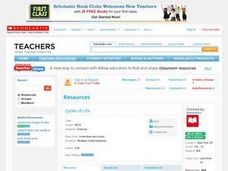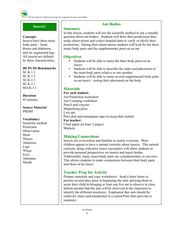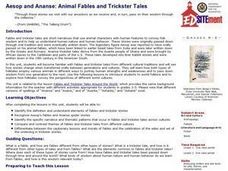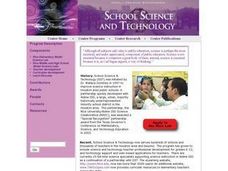Curated OER
Simplified Botany--Leaf Chromatography
Young scholars investigate the different pigments contained in green leaves by completing an experiment that strips away the chlorophyll and separates the pigments left behind.
Curated OER
Cycles of Life
Students explore the metamorphosis of an insect as it changes from an egg to pupa to an adult. the process of change is observed, recorded, and transformed into a life cycle picture.
Curated OER
The Water We Drink
Third graders relate that the quality of their drinking water is subject to the condition of the environment and water found in streams and creeks in their community. They track the travel of a wad of paper from a student's desk to a...
Curated OER
Storytelling In America
Students discuss how Washington Irving is considered an important 19th century-American storyteller. They create their own version of a passage from 'The Legend' after listening to the story.
Curated OER
Ant Bodies
Students name the three parts that comprise an insect body. In this ant lesson plan, students make connections regarding the curiosity of insects as it touches upon the students' personal perspectives. Students then observe ants in class...
Curated OER
Aesop and Ananse: Animal Fables and Trickster Tales
Students complete compare and contrast activities dealing with fables and trickster tales to determine how each uses animals to portray human characteristics, specifically strengths and weaknesses, as well as pass wisdom from one...
Curated OER
Solid Waste and Recycling
Students demonstrate effects of waste on environment and ways of reducing it, observe how much packaging goes into bag lunches each day, and survey their families to assess awareness levels and household recycling practices. Lessons all...
National Endowment for the Humanities
Lesson 2: What Has Happened in the White House?
Working in small groups, or individually, learners are given images of events that took place at the White House. They study the image and research that time in history to better understand how the White House has been affected by...
National Endowment for the Humanities
Lesson 3: On the Road with Marco Polo: From Hormuz to Kashgar
Young explorers examine the route that Marco Polo and his father traveled to reach China. They examine online maps of the Silk Road and harsh terrain of Afghanistan to determine challenges that may have been encountered during travel.
Curated OER
Goldilocks and the Three Bears
Students read and discuss the story "Goldilocks and the Three Bears" and design a structure that will withstand a clay bear's force sitting on it. They develop a list of activities that the three bears do that real bears can't do, and in...
Curated OER
Understanding the Water Cycle
Investigate the water cycle and how water moves from the land to the air and back to the land. Create a terrarium and observe the water cycle at work. Define weather terms including evaporation, condensation, and precipitation.
Curated OER
Science: The States of Matter
Third graders conduct experiments in matter to create chemical changes resulting in gases. By mixing solids and liquids, they create a chemical reaction and capture the gas in balloons. After observing the balloons fill with carbon...
Curated OER
Cup Capacity Tool: Measuring Cup
Students examine containers and their capacity. They fill a one-cup measuring cup with water and pour cups of water into other containers. Through observation, students discover how many cups make a pint, and how many teaspoons make a...
Curated OER
Move It!!!
Students explore motion by observing the movement of people and duplicating those movements. They compare and contrast various kinds of movements and identify different types of movements in pictures. They build an object that can be...
Curated OER
Newton's First Law of Motion with a Glider
Third graders examine, analyze, study and memorize Newton's First Law of Motion utilizing a glider to demonstrate the process. They state, sing, draw or enact an example/illustration of Newton's First Law of Motion in front of their...
Curated OER
Losing Ground
Students examine how effects of farming practices in the early 20th Century contributed to severe soil erosion of a large portion of the North American grasslands.
Curated OER
Bubble Mania
Elementary schoolers practice measuring a soap bubble print. They follow a recipe to make a soap bubble solution. Pupils use the soapy solution to blow large bubbles with a plastic drinking straw until they pop leaving behind a circular...
Curated OER
Tangram
Students explore tangrams. In this tangrams instructional activity, students read Three Pigs, One Wolf, and Seven Magic Shapes and then complete a WebQuest on tangrams. Students explore shapes and rotation during the WebQuest and create...
Curated OER
Au Marche Sandaga a Dakar
A 3-day French lesson targeting food shopping vocabulary. It is designed for elementary French learners pretending to communicate with merchants in a small village outside of Dakar. The plan follows a class reading of the picture book,...
Curated OER
States of Matter Lesson
Second graders identify the three phases of matter and demonstrate how a property can change states of matter. In this states of matter lesson, 2nd graders make an Ooze to discover how a solid changes into a liquid. Students create an...
Curated OER
Applied Science - Science and Math Lab
Create three dimensional objects in an applied science lesson. The goal is for your class to recognize, compare, and model shapes. Using cookie cutters and clay or play dough, they create models for three-dimensional shapes.
Curated OER
Poetry: Walking With My Iguana
Bring a little excitement to your next poetry analysis lesson. Using the highly energetic poem "Walking With My Iguana," learners consider poem structure and rhyme. They listen to the poem, discuss the rhythm and tone with their...
Curated OER
Museum Gallery
Children of all ages examine original art in an art gallery. They view art at an art gallery, then view reproductions, and compare and contrast the two works of art.
Curated OER
Our Natural Resources
Your class will learn about natural resources and man-made items and differentiate between them. They chart resources from seven pictures and explain how each natural resource is used.

























